6: The Late Renaissance/Mannerism
( \newcommand{\kernel}{\mathrm{null}\,}\)
Introduction
One act by a defiant German Augustinian monk changed the political and religious course of Europe in the 1500s. Martin Luther protested the materialism and corruption of the Roman Catholic Church. At this time, he listed 95 arguments against the use of indulgences by the Catholic Church. Indulgences were basically a get out of jail free card that stated if you paid the fee, you would be allowed into heaven. Indulgences could be purchased for yourself, for a spouse, or for your children, even if they had passed away. It was 1517 when Martin Luther nailed his manifesto to a church door in Wittenberg, Saxony. His criticism of the overly corrupt Roman Catholic Church was justified, and he wished to reform the Church through his arguments. However, by 1520, he was excommunicated from the church and a price was placed on his head by the Medici Pope Leo X.
The result of this protest by Luther was a split in the power of the Roman Catholic Church. For over 1000 years, the Roman Catholic Church had ruled supremely over large swaths of Europe. Now that power was challenged by Luther's arguments. The fact that he protested the tenants of the Roman Catholic Church led to the term Protestant being used to describe the new Christian faith for those practicing Christianity outside of the orthodoxy of the Roman Catholic Church. Except for Italy, France, and Spain, other traditionally Roman Catholic regions embraced the new religion that emphasized a personal relationship with Jesus and a personal faith developed from the studies of the Gospels, and the Old Testament. With this new religion, the priest was no longer in a position to act as an intermediary for a person's salvation. Stripping the Roman Catholic Church of this authority had profound effects on Christian imagery as well. The cult of the Saints and of the Virgin Mary, both strong within the Roman Catholic faith had less meaning in this new Protestant movement. The need for sacred images and icons of the faith remained in the areas where Roman Catholicism was strong, but we find a waning of these images in Protestant Europe.
Another interesting result of this religious upheaval involves King Henry VIII, who desired a male heir of his bloodline to the throne above all else. He requested an annulment from his marriage, but was denied by the pope, resulting in a bitter conflict. He then decided to split from the Roman Catholic Church and placed himself as the chief authority over the newly formed Church of England. This had far reached effects since England and France, a Roman Catholic holdover, were close graphically yet very different in terms of Christian beliefs. France remained Roman Catholic for the most part, and England was now split between Protestants and Roman Catholics. There was certainly the potential for violence, and religious persecution would ensue in the coming years against Catholics. Many Catholics leave England and would travel by ship to the Colonies in America. Baltimore, my hometown, would become one of the Catholic strongholds in the years to come. We also see the same violent tendencies spilling over in more recent years in Ireland between the Roman Catholics and the Protestants.
With all the turmoil in Europe at this time artists were also affected and influenced by the events that were taking place. The violence that occurred during the sack of Rome by Spanish and German forces shook the Roman Catholic Church and the Catholic faithful to their core. One of the most graphic responses in art is that of the Last Judgment painted by Michelangelo at the altar wall of the Sistine Chapel. In this dynamic and forceful painting, Michelangelo paints Jesus as the enforcer and ultimate judge for the sins of humanity. We see many damned falling towards the bottom of the fresco in horror and agony as they are doomed to eternity in hell. Jesus is represented as the massive, muscular, and strong Son of God with his right hand lifted in judgment. It is enough to strike fear in the faithful and to encourage repentance. This is a strong representation of the type of Counter-Reformation the Roman Catholic church will use to encourage the faithful Catholic church body to remain faithful to the teachings and sacraments of the church.
https://www.youtube.com/watch?v=ombPQ6egLE8
https://www.youtube.com/watch?v=4mpFcaeElCs
https://www.youtube.com/watch?v=W-mxg-LYaF4
Sculpture and Architecture

Vestibule of the Laurentian Library, Florence, Michelangelo begun 1523
Michelangelo’s design of the Laurentian Library vestibule shows a breaking away from the strict directives of the Classical Orders. Instead, Michelangelo uses classical forms as they suit his design. He mixes and matches curved and pointed pediments, even breaking into the shapes when it suits his needs. He originally wanted to include columns in the space, but realized the space is not large enough to accommodate those forms. So, his elegant solution is to recess the columns into the walls. Note his doubling up of the columns, a stylistic device he’ll use again in the dome of the New Saint Peter’s. The staircase itself is cascades down like an organic waterfall that spills out to the right and left. The color choices are similar to those used by Brunelleschi in his architectural works in Florence. Michelangelo would have been familiar with those buildings and aesthetic. What Michelangelo achieves in this space is a treatment of architectural design as sculpture, a pliable medium with creative possibilities. Architects who follow will have the freedom to explore more imaginative designs using classical forms, but not necessarily bound by strict stylistic codes.

Tomb of Giuliano de ‘Medici, New Sacristy, San Lorenzo, Florence, Michelangelo 1519-1534
https://www.youtube.com/watch?v=5gVlGU4zUeY
The funerary chapel for the Medici family was commissioned by Pope Leo X, with subsequent support by his cousin Pope Clement VII. This project was never completed and so we only have a glimpse at Michelangelo’s architectural and artistic vision for the space. This, along with The Laurentian Library, show Michelangelo using classical forms for artistic, not functional purposes. He is foremost a sculptor, and approaches these design projects through the lens of sculpture.

Pietà, Michelangelo 1546
The Pietà at the Opera del Duomo in Florence was sculpted by Michelangelo from a huge block of white Carrara marble between 1547 and about 1555, on the eve of his 80th birthday. It is one of the three Pietà sculpted by the great artist and expresses his life experiences and human suffering. Unlike the other two—his youthful work in the Vatican and the later Rondanini—the body of Christ is not only supported by Mary but also by Magdalene and the elderly Nicodemus, to whom Michelangelo gave his own face. This detail is confirmed by two biographers, the artist’s contemporaries Giorgio Vasari and Ascanio Condivi, thanks to whom we know that the sculpture was made for an altar in a church in Rome, beneath which the artist wished to be buried. The Pietà of Florence, Michelangelo’s masterpiece, “like other sculptures by Buonarroti,” said Timothy Verdon, director of the Museum, “is considered an unfinished work, though the most suitable wording for it would be that of the 16th century when it was still called an infinite work.”
https://www.friendsofflorence.org/projects/michelangelos-pieta-opera-del-duomo/
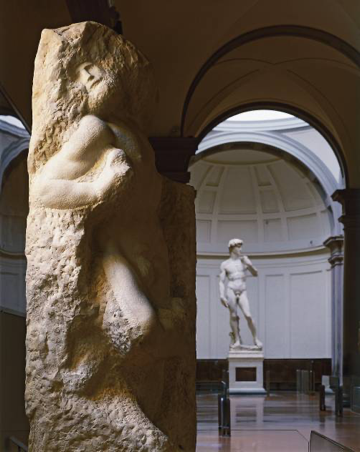
Incomplete Work by Michelangelo
https://www.youtube.com/watch?v=h44bnIGogu8
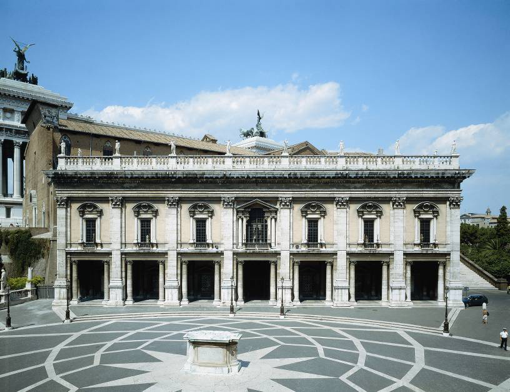
Palazzo dei Conservatori, Campidoglio, Rome, Michelangelo designed 1545
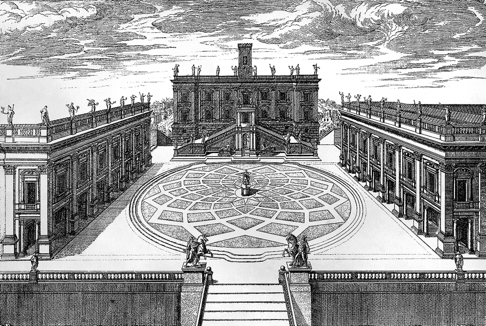
The Campidoglio (engraving by Étienne Dupérac, 1569) Michelangelo
https://museicapitolini.org/en/infopage/palazzo-dei-conservatori
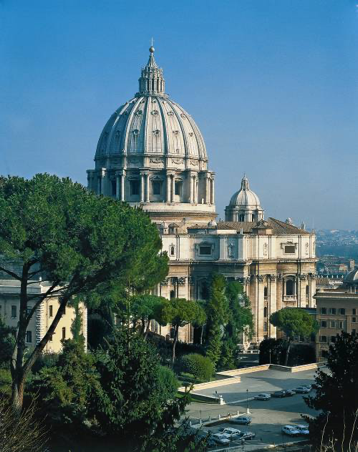
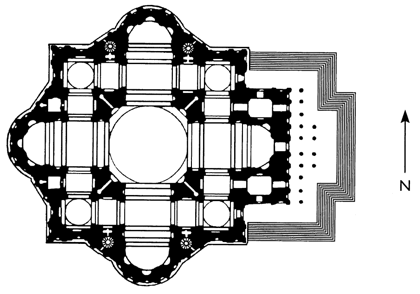
St. Peter’s Rome, Michelangelo 1546-1564; dome completed by Giacomo della Porta, 1590
With similarities to central plan churches and to the now famous dome of the Florence Cathedral, Michelangelo designs the dome for the New Saint Peter’s. Novel elements include the double faux columns used to create a visual texture.
https://smarthistory.org/st-peters-basilica/
https://www.youtube.com/watch?v=ua_lEuQguIA

Courtyard, Palazzo del Te, Mantua Giulio Romano, 1527-1534
The Palazzo del Te is a wonderfully designed space evoking the spirit of the classics. References to classical Greek temple forms are apparent throughout the design with playful and creative artistic alterations such as the lowered triglyphs in the running entablature. The faux double columns remind us of the double columns used by Michelangelo. Simple Doric columns create an elegant simplicity and textural contrast with the rectangular stonework filling the vertical spaces. Alternating arches and rectangular faux windows, doorways, and openings create a logical rhythm to the space.

Courtyard of the Palazzo Pitti, Florence, Bartolommeo Ammanati 1558-1570
Texture is the main art element standing out in the design of the courtyard of the Palazzo Pitti. As in the Ancient Roman Colosseum, the three classical orders are featured with Doric on the first floor, Ionic on the second story, and Corinthian columns featured on the third story. Arches, classical pediments are designed into the structure as ornamentation. Following the sculptural approach to architecture that Michelangelo presents in earlier designs, Ammanati exercises artistic freedom while incorporating classic themes.
http://www.museumsinflorence.com/musei/Pitti_palace.html
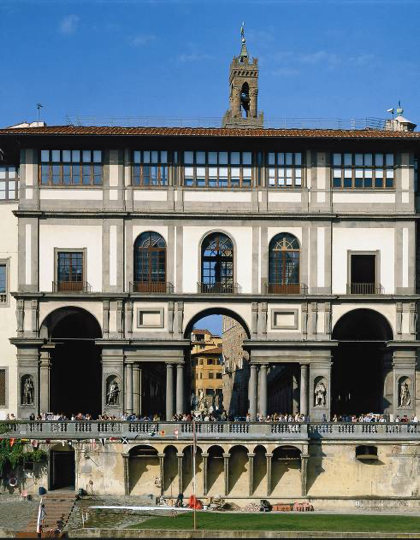
Façade of Uffizi, Florence, Giorgio Vasari, begun 1560
Vasari pays homage to the greats who came before him in this grand architectural design. We see the classical balance and functional columns used by Brunelleschi as well as the doubling of columns as introduced by Michelangelo. Balance, logical geometric spaces, Roman arches, and subtle contrasting colors and values come together in Vasari’s design.
https://www.uffizi.it/en/the-uffizi
https://www.florenceartmuseums.com/uffizi-gallery/
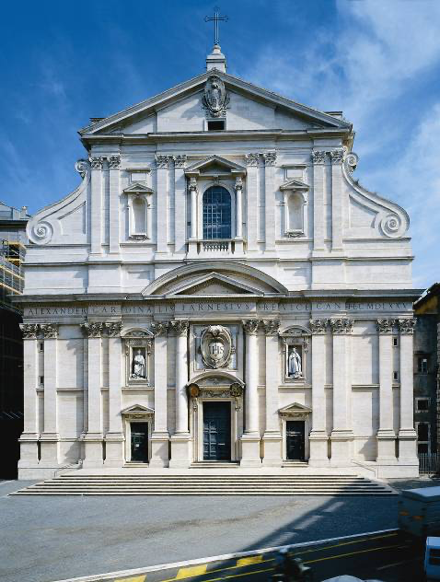
Façade of II Gesù, Rome, Giacomo della Porta, 1575-1584
Working in the style of Alberti, della Porta creates a classical façade for the Jesuit church.
https://www.youtube.com/watch?v=aj2el_owSg4
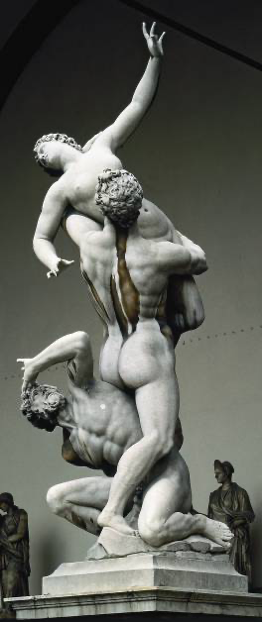
The Rape of the Sabine Women, Loggia dei Lanzi, Florence, Giovanni Bologna, 1583
After the death of Michelangelo, a possible successor is Giovanni Bologna who carves in marble a difficult piece with three intertwined figures. Although the intent was to successfully incorporate the three nudes, it was later suggested that the scene resembles the legendary Rape of the Sabine Women. The title stuck and so we now know the work by that name. It was a very difficult proposition to sculpt a work with the figures rising up in such fashion.
Painting in Italy
A style of painting emerging in the 16th century is known as Mannerism. The paintings in this style are often bizarre and oddly styled with juxtaposed figures, odd compositional devices, and multiple lighting sources. There is a distinct departure from the balanced and beautiful paintings by Renaissance artists like Rafael and the Italian painters who proceeded him. It appears that these artists knew that they could not compete with the great works of the High Renaissance artists and instead went their own creative direction. It is a distinct style that is easily recognizable because of the bright color palettes and eccentric and emotional depictions of the figures.
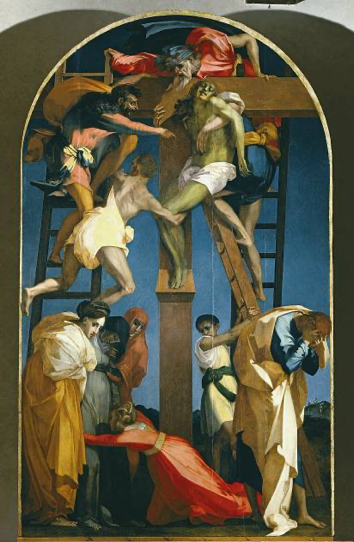
The Descent from the Cross, Rosso Fiorentino, 1521
The Descent from the Cross by Fiorentino was painted for followers of the cross of Jesus a specific sect of monks. In this painting, Jesus is being carried down from the cross upon which he was crucified. The monks who funded this painting are depicted in the scene. The scene itself is very chaotic and unconventional in terms of the composition and spacing. Visual forces within the painting itself direct the viewers eyes across the painting in awkward movements. There are strong diagonals. Even the figure on the lower right in agony directs us out of the painting which would be unheard of in Early and High Renaissance painting. The colors are bright and unusual. Jesus’s body has a strange off color hue in greyed green depicting the lifeless form. The figures of the monks are very animated and agitated as they argue over how to bring Jesus's body down from the cross. Although Jesus reportedly passed away around 3:00 PM in the afternoon, the scene itself has a very dark sky and is illuminated from the upper right and lower right with strong lighting. This creates strong areas of contrast and drama within the painting.

The Entombment, Santa Felicità, Florence Jacopo da Pontormo 1526-1528
The Entombment painted by Pontormo is an intriguing work of art that once again shows some of the chaos and drama in Mannerist paintings. Pontormo places himself to the left of Mary in the background in a self-portrait. The space is packed with figures, and in many ways does not make visual sense. We have no less than four light sources illuminating the scene. The cloud in the upper left of the scene is lit from above left. Yet, the figure on the upper right in the green top is illuminated from upper right. Mary is also illuminated from the upper right, yet the figure coming to support her from the lower right is illuminated from the lower right. The two figures supporting the body of Christ both look very concerned and worried and turn to engage the viewers. They are illuminated by light coming from the lower left. Jesus himself is illuminated from the right. Jesus's body is also a slightly different hue suggesting his passing on the cross.
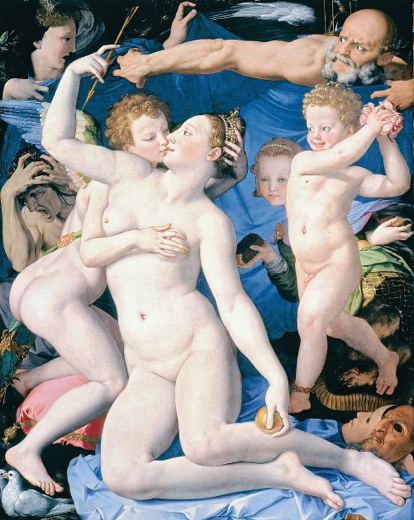
Allegory of Venus, Angolo Bronzino, 1546
Allegory of Venus is a puzzling and intriguing painting by Angolo Bronzino in 1546 that is both erotic and incestuous. Venus is being embraced by her son Cupid as he fondles her breast and gives her a kiss. The Cupid-like figure behind Venus is ready to throw flowers on the two of them, while a male figure, often referred to as Father Time is pulling back the cloth that was covering them. Other figures may represent Jealousy and Fraud. While the beautiful childlike face behind the Cupid-like figure has a body resembling a serpent while her hand holds out a honeycomb. The color Palette is pure Mannerist. The visual space Is packed with figures and very dynamic, although oddly composed. It is believed that this painting was commissioned by Cosimo I de Medici as a gift for King Francis I of France. Paintings like this were meant for personal delight and as conversation pieces, as well as visual puzzles to be solved. We do not know the exact meaning of the figures in the painting since there is not any related written documentation.
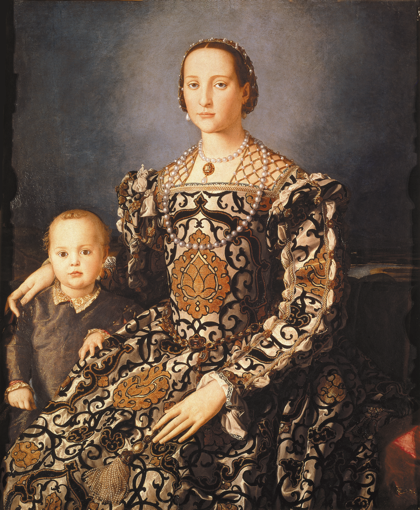
Portrait of Eleanora of Toledo and Her Son Giovanni de‘Medici, Angolo Bronzino, 1550
Bronzino gives us another painting commissioned by the Medici family in the Portrait of Eleonora of Toledo and her son Giovanni de’ Medici by Bronzino. This is a more traditional painting that emphasizes the family heir To Medici power. Eleanora, although the subject of the painting, is not presented to us in a flattering manner other than her elaborate dress, which is exquisitely embroidered showing the wealth and power of the Medici family. Also featured in the painting is her son Giovanni who in many ways is the most important subject in the painting, since he is the Medici heir.

Jupiter and Io, Correggio, 1532
Jupiter and Io, by Correggio, is a magnificent painting showing a moment in time when the two embraced. You can see Jupiter's face and hand in the smoky mist as he embraces Io and kisses her on the cheek. She welcomes this embrace. Io is painted with her clothing beside and under her as she leans back on the rocks. Paintings like this were often gifts given to royalty and for private consumption.
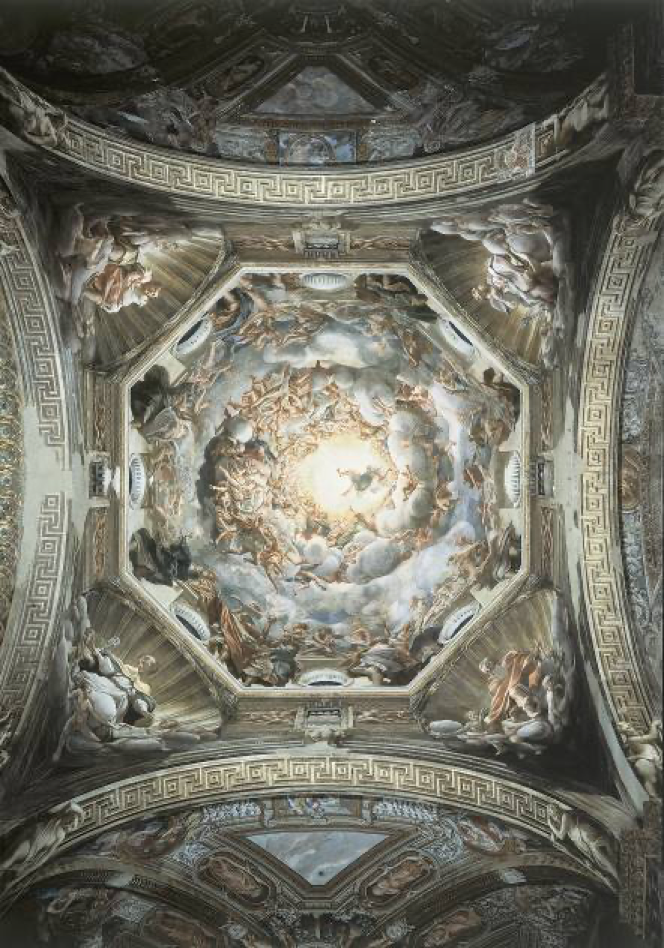
The Assumption of the Virgin, Dome of Parma Cathedral, Parma Italy, Correggio 1522-1530
Correggio gives us a fantastic Counter Reformation painting of Mary being lifted into heaven in bodily form. She is uncorrupted and ever virgin in this heavenly scene painted in fresco, with the Saints and religious dignitaries represented in the clouds as she rises up towards the light of God in what is an impressive use of three- point perspective on the Dome of the Parma Cathedral. Never had such an illusionistic fresco been created. It is really a great visual illusionistic achievement by Correggio.

Self Portrait, Parmigianino 1524
Parmigianino was a child prodigy and displays his great talent in this self-portrait painted in his early 20s. He was fascinated by seeing a convex form and decided to actually paint on a convex surface. In this painting, he gives us the illusion of this visual distortion represented in a reflected convex surface.
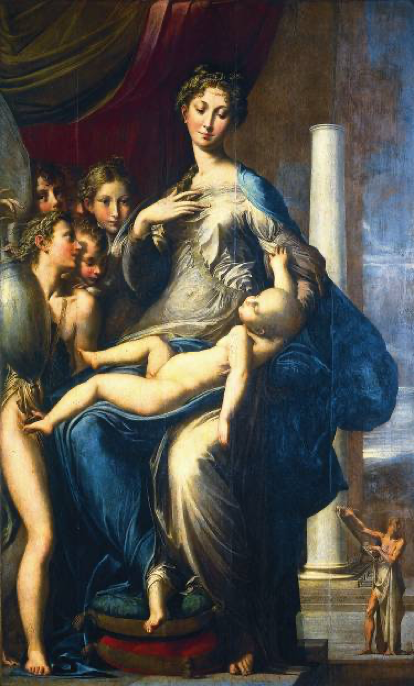
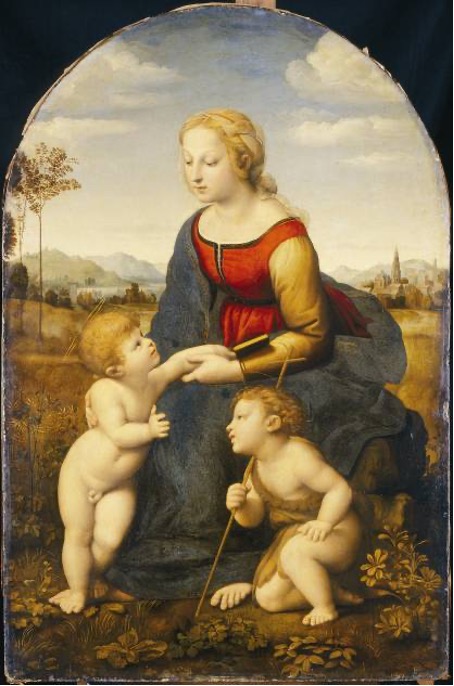
The Madonna with the Long Neck, Parmigianino 1534. La Belle Jardinière, Raphael 1507
Parmigianino painted The Madonna with the Long Neck in 1534 in a Manneristic style. The body proportions are quite odd, whereby the torsos are rather short, and the legs are massive and long. Mary looks down adoringly at her son Jesus, while a crowd of young girls press forward in anticipation to see the child. The upper left lighting focuses on Mary and Jesus. Her blue cape billows out on her left side, like the painting techniques used by Raphael in his paintings of Mary and Jesus. What appears to be an Old Testament prophet holding a scroll stands in the background in front of a huge column from an unfinished structure. Representations of figures in interior spaces with landscapes going off into the distance became popular after Leonardo da Vinci's painting of the Mona Lisa. We see similar paintings by artists such as Giorgione and Titian with reclining nudes in interior spaces and landscapes visible through the window openings. This is an odd painting where the child Jesus looks as if he's going to slide right off Mary's lap. This leaves the viewer feeling a little unsettled and anxious. Once again, this Mannerist painting gives us an odd juxtaposition of beauty and an unbalanced composition.
https://www.youtube.com/watch?v=suIUUGdNyWk
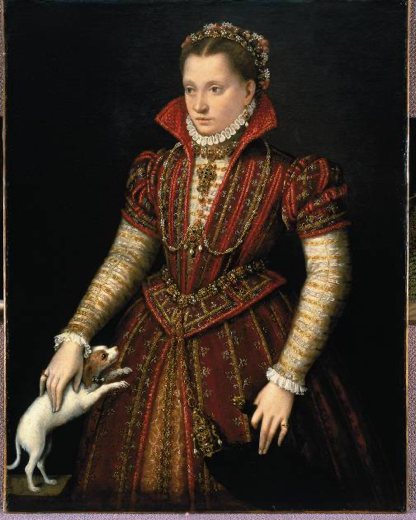
Portrait of a Noblewoman, Lavinia Fontana 1580
Lavinia Fontana is a female painter. Who created several works of note.
The Venetian Painters
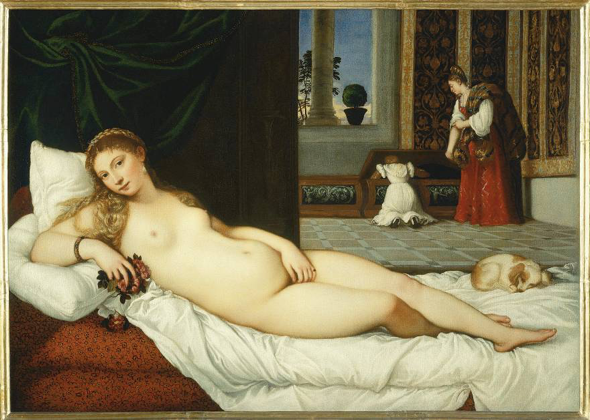
Venus of Urbino, Titian 1538
The Venus of Urbino by Titian in 1538 gives homage to his painting mentor Giorgione and his painting of Sleeping Venus from 1509. The paintings are very similar, although in Titian's painting, Venus is gazing directly at us and is very alert and aware. The sleeping dog at the base of the bed represents fidelity, and other objects within the painting have specific meaning to Venus herself, such as the Myrtle tree and the flowers. The interior is like Venetian interiors of the day, and the two attendants appear to be gathering her garments at this early morning hour as the sun rises. It is an erotic painting showing Titian at the height of his artistic abilities
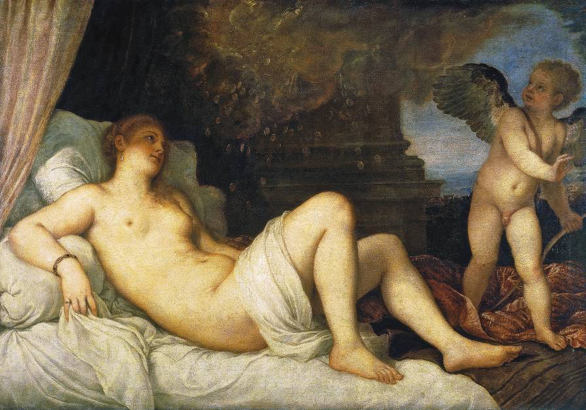
Danaë, Titian 1544-46
Titian, who painted religious scenes as well as secular themes, also delves into Pagan mythologies and legends. You can see this in several of his paintings, including Rape of Europa painted in 1559 to 1562, and in this painting of Denaë. In Denaë, we see a more relaxed female nude represented in a reclined position with, once again, the landscape background painted in beyond the interior. Drapery Is beautifully rendered just as observed in Venus of Urbino.
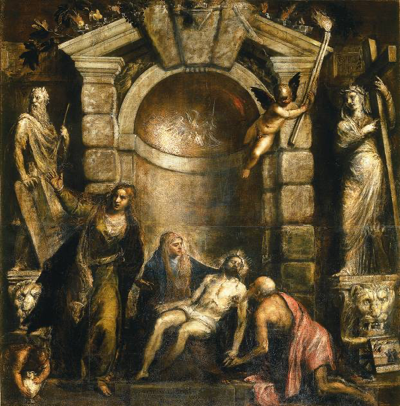
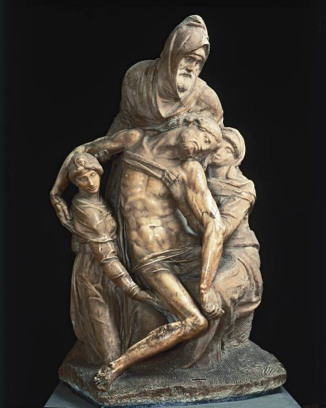
Pietà, Titian 1576 Pietà, Michelangelo 1546
Both Titian and Michelangelo produce work through both the High Renaissance and Mannerist Periods. Both continue to create well into their late years, and we see a distinct change in attitude and feelings in their work. Titian’s work becomes less refined and more emotional as does Michelangelo's. Both works depicting the Pietà are humble and much less confident as in their earlier works of similar subjects. Michelangelo even includes himself as the man supporting the body of Jesus. The body of Jesus in this sculptural work feels very heavy, with the limbs awkwardly placed. The body is being supported by three figures from the sides and from the back in what is a triangular compositional shape. One really feels the weight of the world bared by Jesus as he sinks towards the ground with gravity pulling on his form. It is a very emotional work, far from the sublime and beautiful Pietà he carved in his 20s. while in Rome.
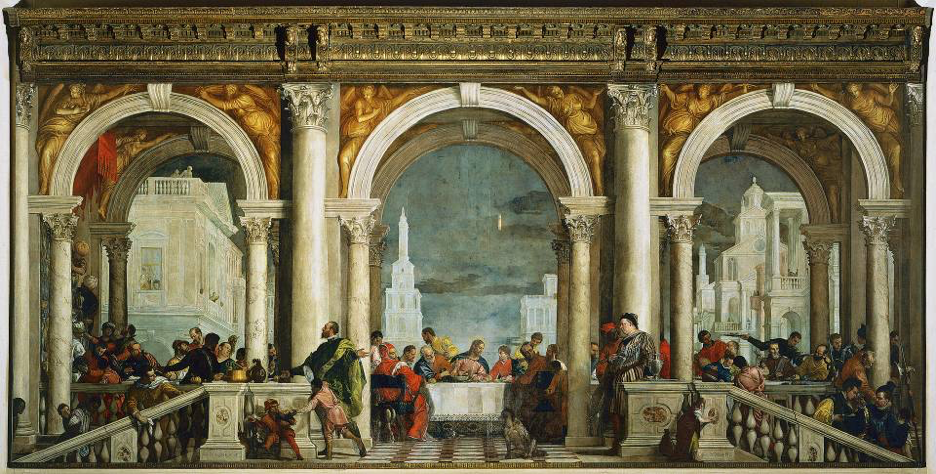
Feast in the House of Levi (The Last Supper), Paolo Veronese 1573
The Counter Reformation led to a formal body of tribunal judges referred to as the Spanish Inquisition. Artists were sometimes attacked for their creative endeavors. Such is the case with the painting The Last Supper by Veronese in 1573. Veronese was called in front of the tribunal to defend his work and a transcript of that event documents the back and forth between the Inquisitors and the artist. They felt that Veronese was making a mockery of the Last Supper and pointedly spoke to specifics of the painting with which they disagreed. In the end, Veronese was given three months to change the painting to match the newly established Counter Reformation standards and requirements of the Roman Catholic Church and the Inquisitors. Instead of making those changes to the painting, he just changed the title of the painting to avoid prosecution. He changed the name to the Feast in the House of Levi. Context is everything, so just changing the name changed the meaning of the painting and moved it out of the reach of the church’s tribunal.
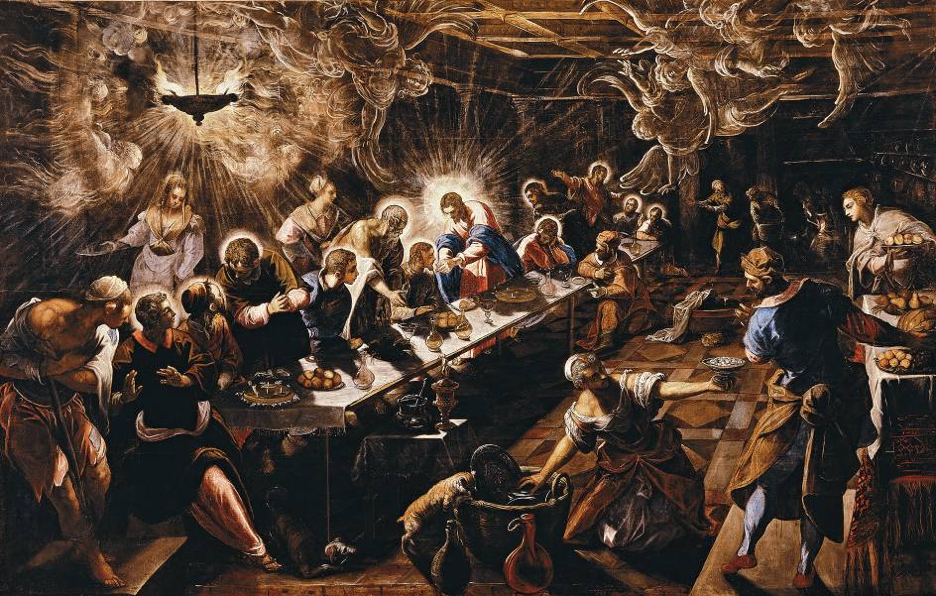
The Last Supper, San Giorgio Maggiore, Venice Jacopo Tintoretto 1594
Tintoretto covers the subject of the Last Supper in vibrant and dynamic fashion. Instead of the stable and refined one-point perspective painting by da Vinci in Milan, he presents a space with diagonal recession, bustling attendants, angels, pets, and the apostles seated beside Christ. Christ offers bread and his halo radiates, as he states, “this is my body, which will be given up for you.” It is a dramatic moment representing this important and significant part of Jesus’s journey here on earth.
Architecture in Venice and Northern Italy
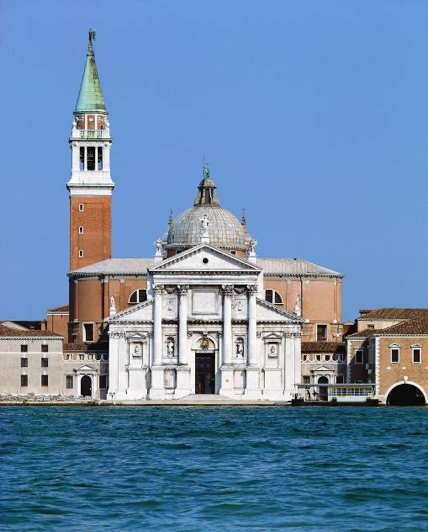

San Giorgio Maggiore, Venice Andrea Palladio 1565
Alberti’s innovative design, including the Colossal Order at Sant’ Andrea Mantua is reflected in the façade of San Giorgio Maggiore, in Venice. This is a façade that resembles closely a Greek or Roman Temple with large Corinthian columns and a classical pediment atop the four large columns. The result is stately, balanced, and harkens back to classical antiquity.
https://collections.vam.ac.uk/item/O617617/elevation-of-the-church-of-drawing-unknown-circle-of/
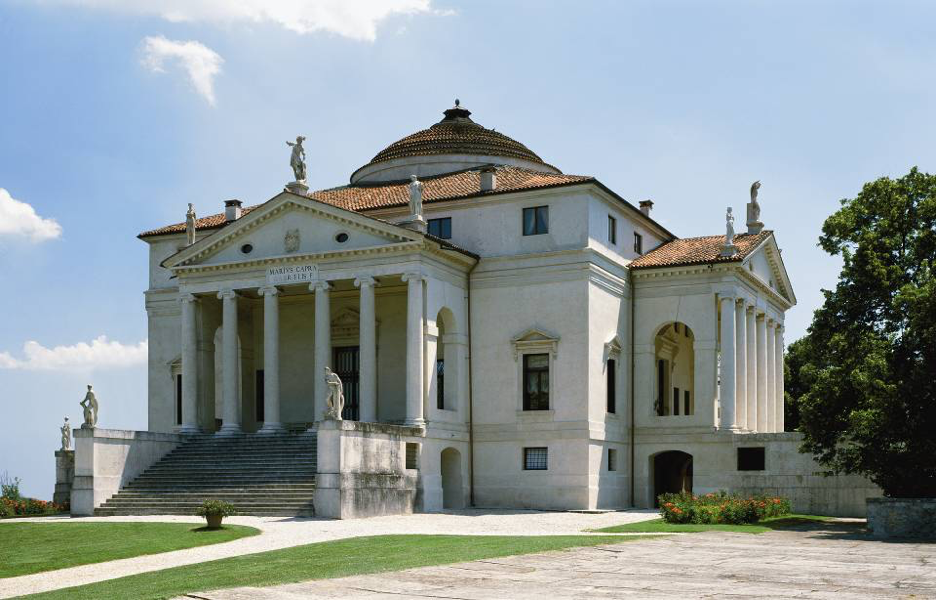
Villa La Rotonda, Vicenza Andrea Palladio 1567-1570
Palladio gives us a complete vision of a classical Ionic building in the Villa Rotunda. True columns support the portico, and the doors and windows are symmetrically placed. Sculpture strategically placed on the roof edges mimic the designs of antiquity.


